#the destruction of pompeii and herculaneum
Photo

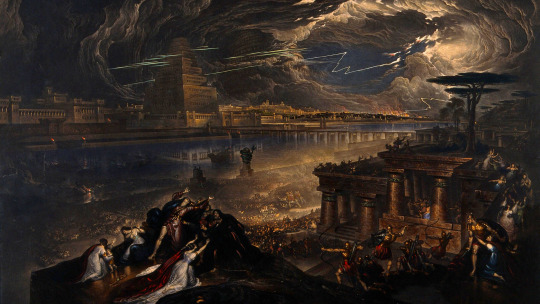
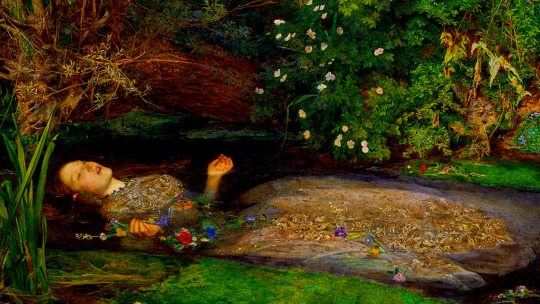
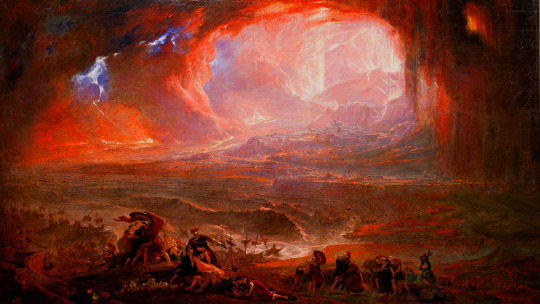




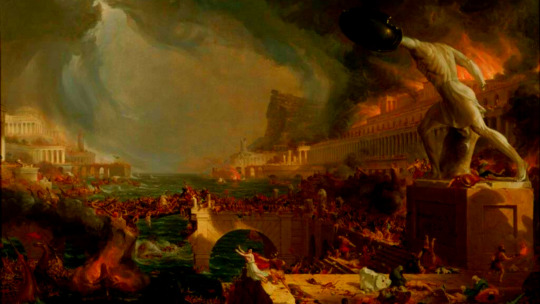

tragedy in art
the execution of lady jane grey by paul delaroche (1833)
the fall of babylon by john martin (1831)
ophelia by sir john everett millais (1852)
the destruction of pompeii and herculaneum by john martin (1822)
princess tarakanova by konstantin flavitsky (1864)
the episode of the yellow fever by juan manuel blanes (1871)
les saltimbanques by gustave dore (1874)
ivan the terrible and his son ivan by ilya repin (1885)
the course of empire, destruction by thomas cole (1836)
the plague of ashdod by nicolas poussin (1630)
#art history#history#the execution of lady jane grey#paul delaroche#the fall of babylon#john martin#ophelia#sir john everett millais#the destruction of pompeii and herculaneum#princess tarakanova#konstantin flavitsky#the episode of the yellow fever#juan manuel blanes#les saltimbanques#gustave dore#ivan the terrible and his son ivan#ilya repin#the course of the empire destruction#thomas cole#the plague og ashdod#nicolas poussin#art#vintage art#vintage
4K notes
·
View notes
Text
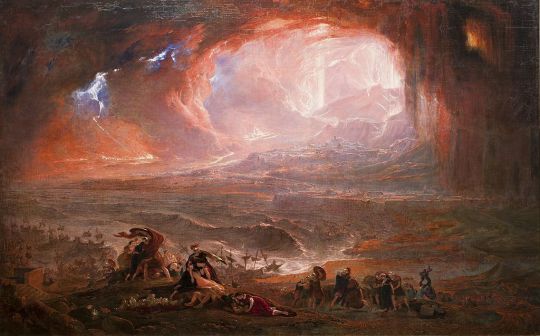
𝘿𝙚𝙨𝙩𝙧𝙪𝙘𝙘𝙞ó𝙣 𝙙𝙚 𝙋𝙤𝙢𝙥𝙚𝙮𝙖 𝙮 𝙃𝙚𝙧𝙘𝙪𝙡𝙖𝙣𝙤 (𝙅𝙤𝙝𝙣 𝙈𝙖𝙧𝙩𝙞𝙣, 1822)
#art#romanticism#painting#the destruction of pompei and herculaneum#john martin#19th century#1822#pompeii#ancient rome#artwork#romanticismo#arte#destrucción de pompeya y herculano#siglo xix#pompeya#antigua roma
9 notes
·
View notes
Text


Details of The Destruction of Pompeii and Herculaneum, painted in 1822, by John Martin
19 notes
·
View notes
Text
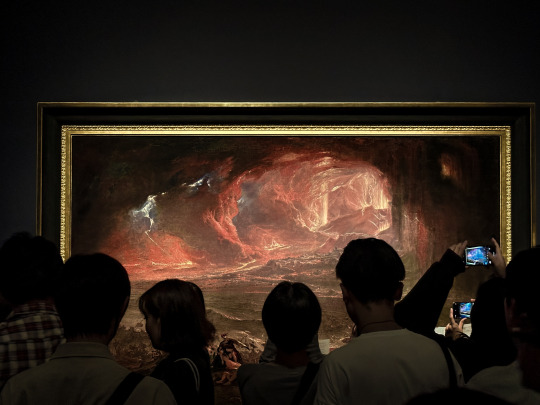
© Paolo Dala
Destruction of Pompeii and Herculaneum
Joseph Martin (1822)
The National Art Center (Minato City, Tokyo, Japan)
Mercy On Those Who Doubt
As Christians we should always remember to have mercy on those who “doubt”. It is our duty to save others by snatching them out of the fire (Jude 1:23).
#Destruction of Pompeii and Herculaneum#Joseph Martin#Art#Painting#Theology#Commentary#The National Art Center#Museum#Gallery#People#Minato City#Tokyo#Japan
1 note
·
View note
Text

The Destruction of Pompeii and Herculaneum (1822) (John Martin)
128 notes
·
View notes
Video
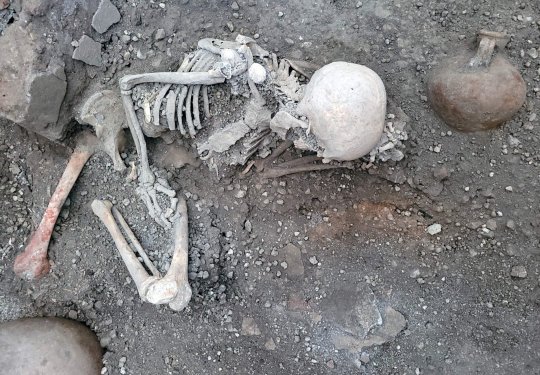
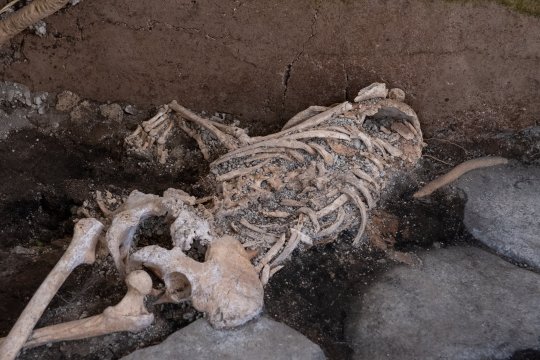

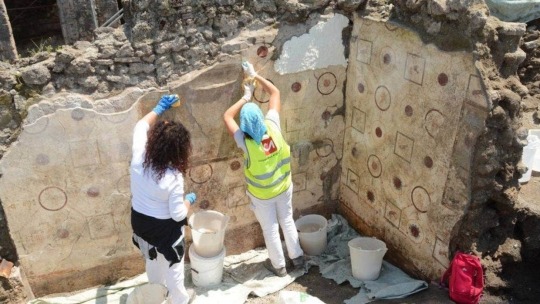


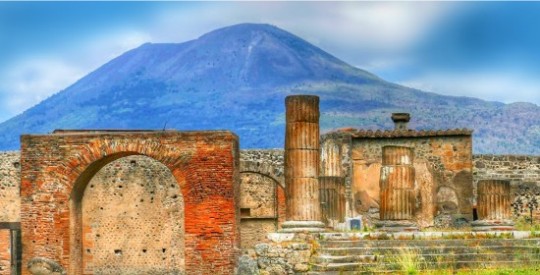
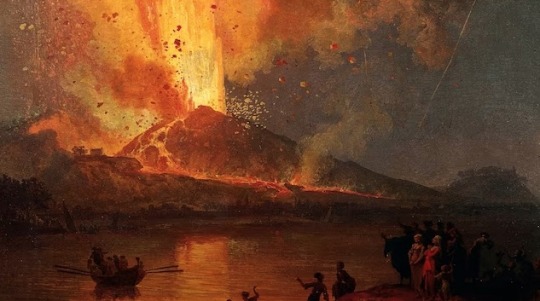
Remains of Three New Pompeii Victims Discovered
The remains of three new Pompeii victims have been unearthed beneath the towering shadow of Mount Vesuvius - almost 2000 years after its catastrophic 79 CE eruption.
The skeleton remains are believed to have belonged to two women and a child, aged between three and four years old.
The trio are believed to have died while seeking shelter in what is suspected to be a bakery, during the first stage of the eruption.
"In these last rooms the bone remains of three victims of the eruption have surfaced," a statement from Pompeii Archaeological Park said.
"Three Pompeians who had taken refuge in search of salvation and who instead found their death under the collapsed attics.
"The individuals were found in an already excavated environment, where only 40cm remained of intact stratigraphy (earth).
"They rested in direct contact with the floor, and presented - together with evidence of important postmortem settlement processes - a series of perimortem traumas due to the collapse of the attic above."
A structure with two intact fresco walls were also discovered as part of the ongoing excavations in an area called Regio IX, a commercial part of town.
One of the walls depicted the sea god Poseidon and Amimone, the other portrays the sun god Apollo and his first love Daphne, who swore to remain a virgin and spurned his advances.
The discoveries come weeks after the remains of two victims, believed to be men, were found beneath a collapsed wall.
The ancient Roman city was destroyed when Vesuvius roared to life the morning of August 24, 79 CE.
By lunchtime the volcano had sent a towering ash and debris cloud into the stratosphere, which rained pumice down on the town as earthquakes rumbled foundations.
This is known as the Plinian phase, which lasted for about 20 hours, and is thought to have been when the three victims perished.
Destruction came for Pompeii in the second eruption stage, known as the Pelean phase.
Pyroclastic surges of molten rock and hot gases surged down the volcano's slopes, burning and asphyxiating people before they had a chance to flee, burying the city.
The eruption is said to have released 100,000 times the energy of the Hiroshima-Nagasaki atomic bombings in World War II.
It's estimated 2000 people died in Pompeii.
However, the exact death toll from the eruption is not known as casualties also occurred in the nearby settlements of Herculaneum, Oplontis, and Stabiae.
#Pompeii#Remains of Three New Pompeii Victims Discovered#Mount Vesuvius#ancient grave#ancient tomb#skeletons#ancient artifacts#archeology#archeolgst#history#history news#ancient history#ancient culture#ancient civilizations#roman history#roman empire#roman art
217 notes
·
View notes
Photo





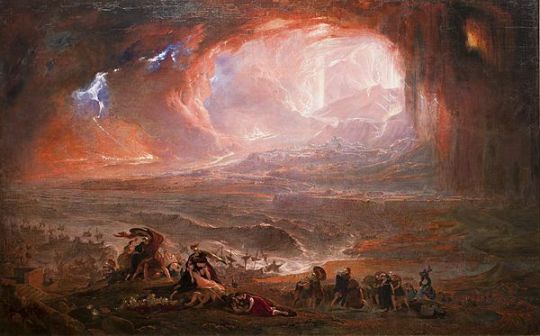


Rural Boys Watch The Apocalypse - Keaton St. James / Epilogue: Dance Like The Devils Watching - Emily Axford / The Destruction of Sodom and Gomorrah - John Martin / Your Money or Your Life (The Comet) - The Paper Chase / Fire and Ice - Robert Frost / The Destruction of Pompeii and Herculaneum - John Martin / Wasteland, Baby - Hozier / When (And If) The Big One Hits, I’ll Just Meet You There - The Paper Chase
#idk my brain is. stuck on this theme at the moment#web weaving#parallels#apocalypse#the paper chase#Emily axford#Robert frost#hozier#mine
481 notes
·
View notes
Text







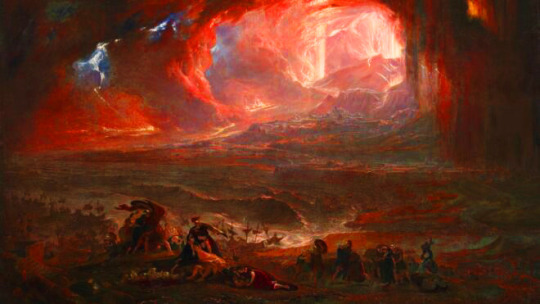


“Meltdown” by Motionless in White // Vision of Valley of Dry Bones by Gustave Dore, 1186 // “What a Time to be Alive” by Fall Out Boy // Supernatural 2.9 “Croatoan” // “Meltdown” by Motionless in White // Nuremburg: Paulus Fürst by Doctor Schnabel vim Rom, 1656 // Revelation 6:8 // The Destruction of Pompeii and Herculaneum by John Martin, 1822 // Revelation 6:8 // Sleepy Hollow (2013-2017)
#web weaving#web weave#compilation poetry#compliation#apocalypse#book of revelation#four horsemen of the apocalypse#fall out boy#so much for stardust#fob smfs#smfs spoilers#smfs era#smfs#fob#supernatural#motionless in white#plague doctor#plaugecore#plagueposting#sleepy hollow#skeletons#spooky
113 notes
·
View notes
Photo








Paintings by John Martin (1789-1854). Top to bottom:
The Destruction of Pompeii and Herculaneum, 1821
The Deluge, 1834
The Destruction of the Pharaoh’s Host, 1836
The Country of the Iguanodon, 1837
Destruction of Tyre, 1840
Pandemonium, 1841
The Great Day of Wrath, 1851
The Destruction of Sodom and Gomorrah, 1852
Mesmerized by the scale of these paintings. The white-hot incandescence of the Vesuvius and Sodom, the weight of sloshing water in the Deluge and Tyre, the sheer size of the crumbling rocks in the Day of Wrath, the murky glow around Pandemonium, the way all human figures are so tiny and vulnerable... (I think the person standing in front of Pandemonium is supposed to be Milton’s Satan)
EDIT: added the Pharaoh, which I had forgot.
115 notes
·
View notes
Photo




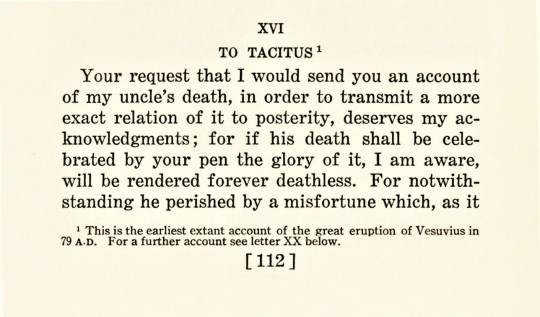

The Eruption of Mt. Vesuvius
The Eruption of Mt. Vesuvius in 79 CE remains one of the deadliest natural disasters in recorded history. Not only did the volcano destroy the economically powerful city of Pompeii, but Herculaneum, Oplontis, Stabiae were also buried and thus lost to the Roman Empire. The number of victims is unknown, but given the size of the four cities, estimates have reached over 18,000 individuals.
Today only one first-hand account of this horrific event survives in two letters from Pliny the Younger to the Roman historian Tacitus. They are preserved as letters 6.16 and 6.20 in the collected Epistles of Pliny. Among our holdings of the works of Pliny is this 3-volume set of the Epistles with William Melmoth’s 18th-century translation edited by Clifford Herschel Moore, and printed by the Harvard University Press in an edition of 405 copies for members of The Bibliophile Society, Boston, in 1925.
While the term ‘volcanic eruption’ evokes scenes of lava and fire, the reality is much more frightening. Curiously, there is no word for volcano in the Latin language. While ancient Romans were aware of the destructive power of volcanoes, there’s some debate about whether they were aware that Vesuvius was a volcano before its eruption. Signs of the eruption began back in 62CE with a great earthquake that caused much of the city to collapse. Smaller earthquakes continued over the next 15 years until one was accompanied by the rise of a column of smoke from Mt. Vesuvius in October 79 CE.
The hot gases that made up the column of smoke began to cool, darkening the sky, and not long after a rain of pumice began to fall, and after 15 hours ceilings began to collapse. Nevertheless, many residents chose to take shelter rather than flee. At 4am the first 500C pyroclastic surge barred down the volcano, burying Herculaneum. Six more of these surges occurred before the end of the eruption, destroying Pompeii, Oplontis, and Stabiae.
The 17-year old Pliny was in the port town of Misenum across the Bay of Naples from the volcano at the time. Pliny’s uncle, Pliny the Elder, commander of the Roman fleet at Misenum, launched a rescue mission and went himself to the rescue of a personal friend. The elder Pliny did not survive the attempt. In Pliny the Younger’s first letter to Tacitus, he relates what he could discover from witnesses of his uncle's experiences. In a second letter, he details his own observations after the departure of his uncle.
Mt. Vesuvius is still active and according to volcanologists, erupts about every 2000 years, which would be right about now. Who will be our next Pliny the Younger?
Our copy of The Epistles of Pliny is another gift from our friend and benefactor Jerry Buff.
View more of my Classics posts.
– LauraJean, Special Collections Undergraduate Classics Intern
#Classics#classical history#Roman History#Mt. Vesuvius#Eruption of Mt. Vesuvius#Pliny the Younger#Epistles of Pliny the Younger#Pliny the Elder#Tacitus#William Melmoth#Clifford Herschel Moore#Harvard University Press#The Bibliophile Society#volcanic eruptions#Pompeii#herculaneum#Oplontis#Stabiae#Jerry Buff#LauraJean
90 notes
·
View notes
Text
The Villa of the Papyri is the name given to a private house that was uncovered in the ancient Roman city of Herculaneum. This city, along with nearby Pompeii, is perhaps best remembered for its destruction during the eruption of Mount Vesuvius in 79 AD. Because of this natural disaster, the buildings of these cities were preserved under a thick layer of volcanic ash.
71 notes
·
View notes
Note
Oo oo oo!!! Pompeii :DDD
Well, even though the event is often called Pompeii, the town of Pompeii wasn't the only place buried in the explosion. The two other towns of Oplontis and Stabiae were also buried by ash, and the town of Herculaneum was buried by a mudslide. Because of the different kind of destruction, Herculaneum is much better preserved than Pompeii is. Pompeii was a relatively poor town and Herculaneum was much richer, so it is home to some very well preserved fancy frescos and architecture that Pompeii doesn't.
16 notes
·
View notes
Text

The Destruction of Pompeii and Herculaneum by John Martin
#eruption#mount vesuvius#bay of naples#pompeii#herculaneum#view#stabiae#vesuvius#apocalyptic#amphitheatre#temple of jupiter#fleeing#citizens#pliny the elder#volcanoes#volcano#ancient#ancient rome#roman#romans#pompeian#eruptions#storm#mediterranean#sea#waves
139 notes
·
View notes
Text
I really can't stand the endless documentaries that are like "OH EM GEE WAS ATLANTIS REAL?!"
NO. IT WASN'T. PLATO ADMITTED IN HIS OWN WRITINGS IT WAS AN ALLEGORY YOU OVERFUNDED CROCKUMENTARY DINGUSES.
Allegory was practically Plato's whole thing. Short of stuffing words in Socrates' mouth (Plato basically considered Socrates to be the wisest man who ever lived and so when he wanted something to sound important or wise, he'd have Socrates say it in his dialogues), it was his favorite method of imparting a lesson. Anyone who claims to be "using Plato's writings as a map to find Atlantis" wasn't ACTUALLY reading those in the manner Plato intended and Plato would have knocked them flat on their ass for it.
Plato may have been a thinking man but he was also RIPPED and not afraid to throw hands — like many Greeks of his age he enjoyed boxing and wrestling and regularly took part in the Isthmian Games and was commented upon by several contemporaries as "a most talented grappler", so let's not pretend this man wouldn't put you on the ground if he thought you weren't getting the message.
And the message was that Plato spun a yarn about how even the greatest, most glorious civilizations can so completely fail and give way to the basest, darkest parts of human nature and decline so far that when the end comes for them, it is not a tragedy, but rather a blessing. The whole point of the Allegory of Atlantis is that they had their chance and they're better off dead, and you should NOT seek to be like them BECAUSE they failed.
In short: "If they were worth emulating, they would still be here. They are neither."
Despite occurring nearly a thousand years earlier, the story of the destruction of the isle of Thera and its golden city of Akrotiri by volcanic apocalypse would have been known to men of Plato's generation (an island effectively deleting itself off the map in a single massive —never mind DRAMATIC— explosion, darkening the skies for miles around, cooling the climate, and wiping out one of the most technologically advanced, wealthy, and prosperous societies to have ever existed in the region is not the sort of thing people in the area tend to just... forget, after all), and since volcanoes would not be even slightly understood until after Pompeii and Herculaneum, the only reasoned explanation at Plato's time would have been "the gods did it", and if the gods did it, they must have had a reason for it, even if that reason was not visible to us mere mortals, and it's from those considerations that the Allegory of Atlantis springs.
As Plato writes in Critias of the destruction of "Atlantis":
By such reflections and by the continuance in them of a divine nature, the qualities which we have described grew and increased among them; but when the divine portion began to fade away, and became diluted too often and too much with the mortal admixture, and the human nature got the upper hand, they then, being unable to bear their fortune, behaved unseemly, and to him who had an eye to see grew visibly debased, for they were losing the fairest of their precious gifts; but to those who had no eye to see the true happiness, they appeared glorious and blessed at the very time when they were full of avarice and unrighteous power.
Zeus, the god of gods, who rules according to law, and is able to see into such things, perceiving that an honorable race was in a woeful plight, and wanting to inflict punishment on them, that they might be chastened and improve, collected all the gods into their most holy habitation, which, being placed in the center of the world, beholds all created things.
We can see Plato's general point summed up in that quote: the people of Atlantis were a good people, a hard working people, and ascended greatly as they emulated that which was best about man and the gods (aka Plato's values), and declined as they ceased to cherish what Plato believed was good and embraced what he considered evil, until they became so fallen, so depraved, and had committed such crimes that Zeus, "who rules according to law", was forced to pass judgment upon and destroy them "in a single day and night of misfortune".
Atlantis was an allegory for how even the mightiest and most virtuous of civilizations can fall prey to the temptations of decadence and pride if your own pride is not paired with self-vigilance. The people of Atlantis were at one time prosperous, virtuous, and rightly proud. But they let their pride get the better of them. They became selfish and overconfident, they let the darker side of human nature rule them.
Plato considered it righteous for the gods to “reward” the selfish and the careless with just vengeance. "When all their pride has been shattered", the principle argues, "they can return to a better, earlier form of what they used to be."
The most illustrative demonstration of Atlantean wickedness and decadence is this line:
To those who had no eye to see the true happiness, they appeared glorious and blessed at the very time when they were full of avarice and unrighteous power.
It's like looking at <spins the wheel of pop culture dystopia> the Capital of Panem from "The Hunger Games" and deciding that since it's full of extravagant fashion, beautiful architecture, and sumptuous foods and everyone is partying constantly, that this is a fundamentally good and happy society. But they aren't. They are prisoners of their own oppressive system and their need to maintain it to keep the status quo preserved, they are slaves to their greed and chronic consumption, and all the selfish and excessive pleasures, all glitz and the glamor, cannot cover up the massive collective void in their society's hearts. The Capital and everyone in it is DEEPLY unhappy and is simply covering it up with more and more surface level comforts and hedonism, trying to "consume away" the pain at the expense of others they have oppressed and effectively enslaved, while their leaders are no happier, unable to enjoy the fruits of their decades of labor establishing their nation, as they know how fragile the house of cards really is, and all fear the backstabbing schemes of others in the leadership structure, with none more feared and fearful than the "King" at the very top, which ends up resulting in the destruction of everything he and those before him have built, and his own personal death as well.
THAT is Atlantis. Atlantis is exactly as real as Panem's Capital. And Atlantis is the same kind of story: a corrupt and wicked dystopia, a once shining society brought low by the worst aspects of human nature, and utterly deserving the destruction wrought upon it.
If Plato were here today, he'd probably say something like "Seek not Atlantis, for you will find nothing — nothing but a tale of man's own inclination towards self-ruin."
8 notes
·
View notes
Text

The Destruction of Pompeii and Herculaneum (1822) John Martin
7 notes
·
View notes
Text

The Destruction of Pompeii and Herculaneum. John Martin, c. 1821.
2 notes
·
View notes